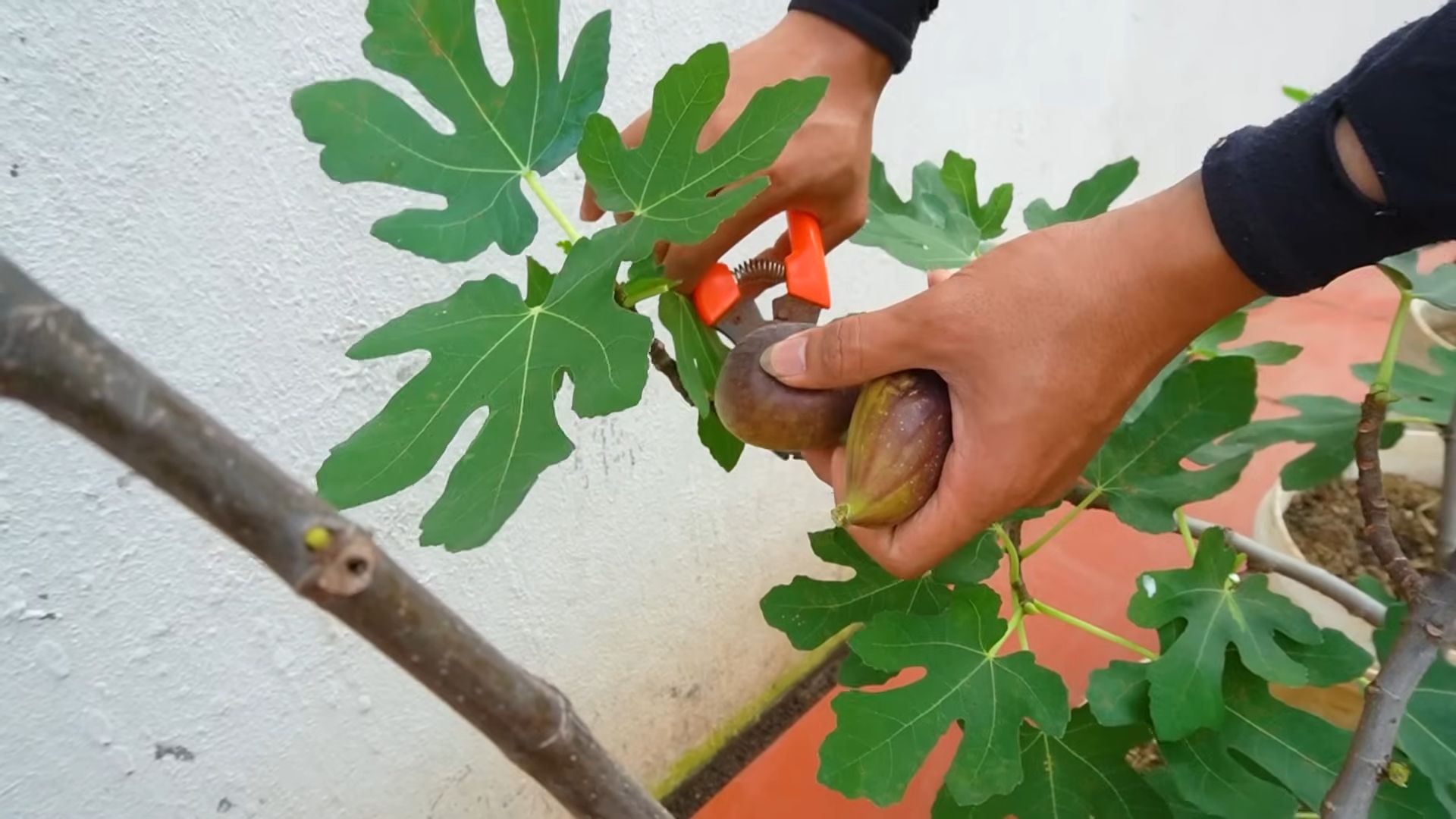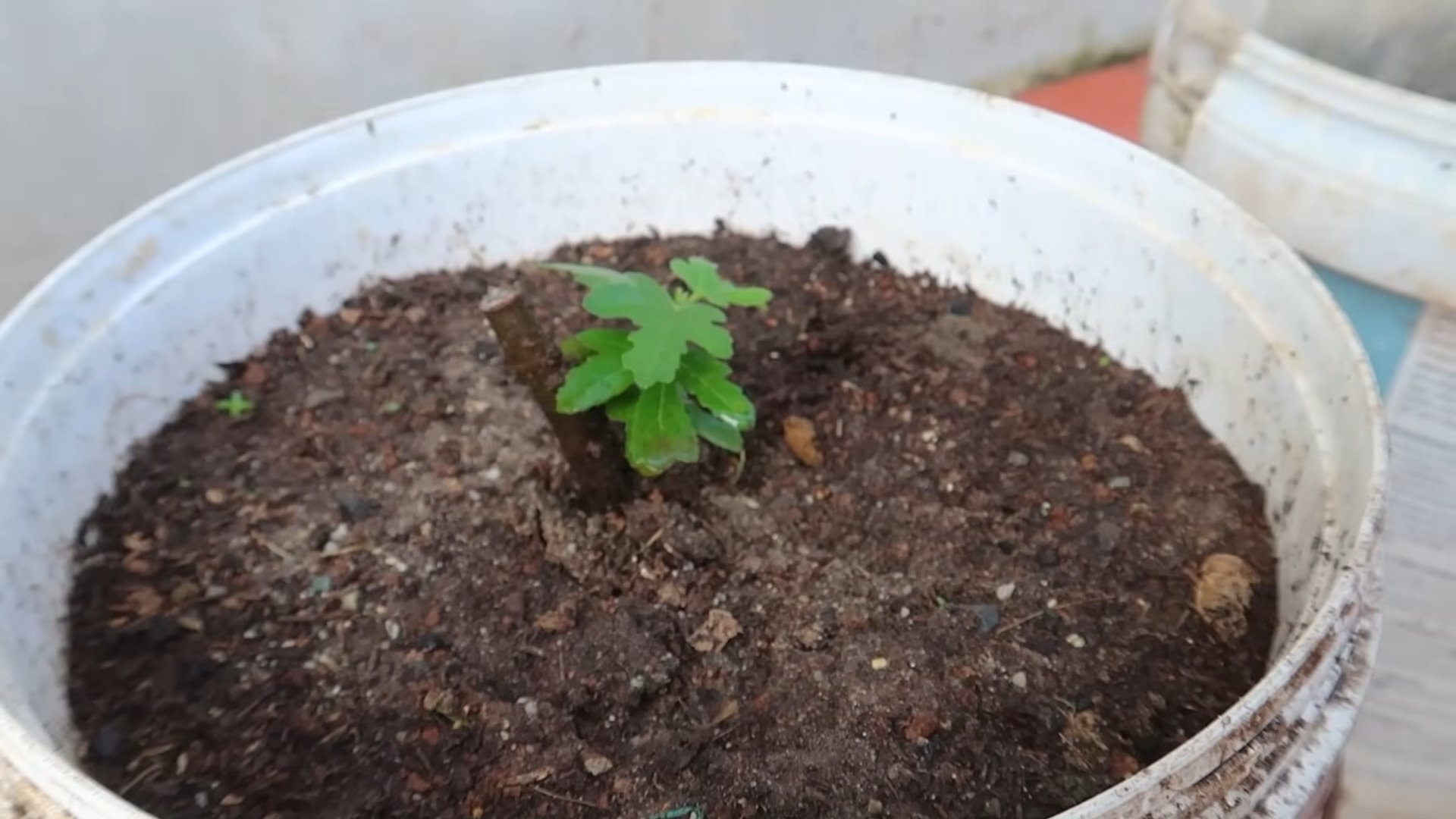Growing Figs Easily might seem like a challenge reserved for seasoned gardeners, but trust me, it’s totally achievable, even if you’re a beginner like I once was! I remember staring longingly at those plump, juicy figs in the grocery store, dreaming of having my own little fig orchard right in my backyard. But the thought of the effort involved felt daunting.
Figs have a rich history, dating back to ancient civilizations. They were prized by the Romans and Egyptians, and even mentioned in the Bible. For centuries, they’ve been a symbol of prosperity and abundance. Now, you can bring that same sense of abundance to your own home with these simple DIY tricks and hacks.
Why do you need these tips for growing figs easily? Well, let’s face it, fig trees can be a bit finicky. They need the right conditions to thrive, and sometimes, traditional gardening methods just don’t cut it. But with a few clever DIY solutions, you can overcome common challenges like pests, diseases, and even limited space. I’m going to share my favorite, tried-and-true methods that will have you harvesting delicious figs in no time. Get ready to transform your garden into a fig-lover’s paradise!

Growing Figs Easily: A DIY Guide to Abundant Harvests
Hey there, fellow gardening enthusiasts! I’m so excited to share my secrets to growing figs – those delicious, teardrop-shaped fruits that are surprisingly easy to cultivate, even if you don’t have a sprawling orchard. I’ve been experimenting with different techniques for years, and I’ve finally nailed down a method that consistently yields a bountiful harvest. This guide will walk you through everything you need to know, from choosing the right variety to protecting your fig tree from the elements. Let’s get started!
Choosing the Right Fig Variety
Before you even think about planting, it’s crucial to select a fig variety that’s well-suited to your climate. Not all figs are created equal! Some are more cold-hardy than others, while some ripen earlier in the season. Here’s what I consider when choosing a fig variety:
* Climate Hardiness: This is the most important factor. If you live in a region with harsh winters, you’ll need a variety that can withstand freezing temperatures. Look for varieties like ‘Chicago Hardy,’ ‘Brown Turkey,’ or ‘Celeste.’ These are known for their ability to survive cold snaps.
* Ripening Time: Consider when you want your figs to ripen. Some varieties ripen early in the summer, while others ripen later in the fall. If you have a short growing season, opt for an early-ripening variety.
* Fruit Size and Flavor: Fig varieties vary in size and flavor. Some produce small, sweet figs, while others produce larger, more complexly flavored fruits. Do some research and choose a variety that appeals to your taste buds. ‘Black Mission’ is a popular choice for its rich, sweet flavor.
* Self-Fertility: Most fig varieties are self-fertile, meaning they don’t require another fig tree for pollination. However, some varieties do require pollination by a specific wasp. Make sure you choose a self-fertile variety unless you’re prepared to deal with the complexities of fig wasp pollination.
Preparing the Planting Site
Once you’ve chosen your fig variety, it’s time to prepare the planting site. Figs thrive in well-drained soil and full sun. Here’s how I prepare my planting site:
* Sunlight: Choose a location that receives at least 6-8 hours of direct sunlight per day. This is crucial for fruit production.
* Soil Drainage: Figs hate soggy soil. Make sure the soil drains well. If your soil is heavy clay, amend it with compost, sand, and other organic matter to improve drainage.
* Soil pH: Figs prefer a slightly acidic to neutral soil pH (around 6.0-7.0). You can test your soil pH with a soil testing kit and amend it accordingly.
* Space: Give your fig tree plenty of space to grow. Depending on the variety, fig trees can grow quite large. I usually allow at least 15-20 feet between fig trees.
Planting Your Fig Tree
Now comes the fun part – planting your fig tree! Here’s my step-by-step guide:
1. Dig the Hole: Dig a hole that’s twice as wide as the root ball and just as deep.
2. Amend the Soil: Mix some compost into the soil you removed from the hole. This will provide nutrients and improve drainage.
3. Remove the Tree from the Container: Gently remove the fig tree from its container. If the roots are pot-bound, gently loosen them with your fingers.
4. Place the Tree in the Hole: Place the fig tree in the hole, making sure the top of the root ball is level with the ground.
5. Backfill the Hole: Backfill the hole with the amended soil, gently tamping it down as you go.
6. Water Thoroughly: Water the tree thoroughly after planting. This will help settle the soil and encourage root growth.
7. Mulch: Apply a layer of mulch around the base of the tree. This will help retain moisture, suppress weeds, and regulate soil temperature. I like to use wood chips or straw.
Caring for Your Fig Tree
Once your fig tree is planted, it’s important to provide it with proper care. Here’s what I do to keep my fig trees healthy and productive:
* Watering: Water your fig tree regularly, especially during dry periods. Figs need consistent moisture to produce juicy fruit. However, avoid overwatering, as this can lead to root rot. I usually water deeply once or twice a week, depending on the weather.
* Fertilizing: Fertilize your fig tree in the spring with a balanced fertilizer. I use a fertilizer with an NPK ratio of 10-10-10. Avoid over-fertilizing, as this can lead to excessive vegetative growth at the expense of fruit production.
* Pruning: Prune your fig tree in late winter or early spring to remove dead, damaged, or crossing branches. Pruning also helps to improve air circulation and sunlight penetration, which can increase fruit production. I usually prune my fig trees to maintain a manageable size and shape.
* Pest and Disease Control: Figs are generally resistant to pests and diseases, but they can be susceptible to certain problems, such as fig rust and spider mites. Inspect your fig tree regularly for signs of pests or diseases and take action if necessary. I use organic pest control methods whenever possible.
* Winter Protection: If you live in a region with cold winters, you’ll need to protect your fig tree from freezing temperatures. There are several ways to do this, including wrapping the tree in burlap, building a frame around the tree and filling it with straw, or moving the tree indoors if it’s in a container. I usually wrap my fig trees in burlap and add a layer of mulch around the base of the tree.
Overwintering Fig Trees in Cold Climates
This is where things get a little more involved, but it’s essential if you want to grow figs in colder regions. I’ve tried a few different methods, and here’s what I’ve found works best:
1. The “Texas Method” (Container Figs): If your fig tree is in a container, this is the easiest option.
* Stop Fertilizing: Around late summer, stop fertilizing your fig tree to encourage it to go dormant.
* Reduce Watering: Gradually reduce watering as the weather cools down.
* Move Indoors: Before the first frost, move your fig tree to a cool, dark, and unheated location, such as a garage or basement. The ideal temperature is between 32°F and 50°F.
* Minimal Watering: Water sparingly during the winter, just enough to keep the soil from completely drying out.
* Acclimatize in Spring: In the spring, gradually acclimate your fig tree to outdoor conditions by placing it in a sheltered location for a few hours each day, gradually increasing the amount of time it spends outdoors.
2. Burying Method (For Smaller, In-Ground Trees): This method is a bit more labor-intensive, but it can be effective for smaller, in-ground fig trees.
* Dig a Trench: Dig a trench next to your fig tree that’s deep enough to accommodate the entire tree.
* Gently Bend the Tree: Carefully bend the fig tree over and lay it in the trench. You may need to prune some branches to make it fit.
* Cover with Soil: Cover the tree with soil, mounding it up to protect it from the cold.
* Add Insulation: Add a layer of insulation, such as straw or leaves, on top of the soil.
* Uncover in Spring: In the spring, carefully uncover the tree and gently lift it back into an upright position.
3. Wrapping Method (For Larger, In-Ground Trees): This method is suitable for larger, in-ground fig trees that are too big to bury.
* Prune: Prune the tree back to a manageable size.
* Wrap the Trunk: Wrap the trunk of the tree with burlap or other insulating material.
* Build a Frame: Build a frame around the tree using wood or wire mesh.
* Fill with Insulation: Fill the frame with insulation, such as straw or leaves.
* Cover with Tarp: Cover the entire structure with a tarp to protect it from the elements.
* Remove in Spring: Remove the wrapping and frame in the spring.
Harvesting Your Figs
The moment you’ve been waiting for – harvesting your figs! Figs are typically ready to harvest when they are soft to the touch and slightly droopy. The skin may also crack slightly. Here’s how I harvest my figs:
1. Gently Pluck: Gently pluck the figs from the tree. They should come off easily when

Conclusion
So, there you have it! Growing figs easily doesn’t have to be a daunting task reserved for seasoned gardeners. With this simple, yet effective DIY trick, you can unlock the potential of your fig tree and enjoy a bountiful harvest of sweet, delicious fruit right in your own backyard.
This method, focusing on strategic pruning and soil management, offers a significant advantage over traditional approaches. It encourages earlier fruiting, maximizes sunlight exposure to the developing figs, and minimizes the risk of common fig tree diseases. Imagine biting into a perfectly ripe, sun-warmed fig, knowing you nurtured it from bud to deliciousness. That’s the reward waiting for you!
But don’t just take our word for it. The beauty of this DIY approach is its adaptability. Feel free to experiment with different pruning techniques to find what works best for your specific fig variety and climate. For instance, if you live in a particularly cold region, consider wrapping your fig tree trunk with burlap during the winter months for added protection. You could also try different soil amendments to further enrich the soil and provide your fig tree with the nutrients it craves. Adding compost tea regularly can boost the microbial activity in the soil, leading to healthier roots and more vigorous growth.
Consider these variations to tailor the method to your specific needs:
* **Espalier Training:** Train your fig tree against a wall or fence using the espalier method. This not only looks beautiful but also maximizes sunlight exposure and saves space, making it ideal for smaller gardens.
* **Container Growing:** If you have limited space, you can successfully grow figs in containers. Choose a large pot with good drainage and use a high-quality potting mix. Remember to water regularly and fertilize during the growing season.
* **Air Layering:** Propagate new fig trees from existing branches using air layering. This is a simple and effective way to expand your fig orchard or share your favorite varieties with friends and family.
We are confident that this DIY trick will revolutionize your fig-growing experience. It’s a game-changer for both novice and experienced gardeners alike. The key is consistency and observation. Pay attention to your fig tree’s needs, adjust your approach as necessary, and you’ll be rewarded with an abundance of delicious figs year after year.
Now it’s your turn! We encourage you to try this DIY trick for growing figs easily and share your results with us. Post pictures of your thriving fig trees and delicious harvests on social media using #EasyFigGrowing or leave a comment below. We’re eager to hear about your successes, challenges, and any variations you discover along the way. Let’s build a community of fig enthusiasts and learn from each other’s experiences. Happy growing!
Frequently Asked Questions (FAQ)
Q: What type of fig tree is best suited for this DIY trick?
A: This DIY trick is generally effective for most common fig varieties, including Brown Turkey, Black Mission, Celeste, and Kadota. However, some varieties may respond better than others depending on your local climate and soil conditions. It’s always a good idea to research the specific needs of your chosen fig variety and adjust your approach accordingly. For example, some varieties are more cold-hardy than others and may require additional winter protection.
Q: How often should I prune my fig tree using this method?
A: The frequency of pruning depends on the age and growth rate of your fig tree. Generally, you should prune your fig tree once a year during the dormant season (late winter or early spring) before new growth begins. However, you may need to do some light pruning during the growing season to remove any dead, damaged, or crossing branches. The goal is to maintain an open canopy that allows for good air circulation and sunlight penetration.
Q: What type of soil is best for growing figs?
A: Figs thrive in well-drained soil that is rich in organic matter. A slightly acidic to neutral pH (around 6.0 to 7.0) is ideal. If your soil is heavy clay or sandy, amend it with compost, aged manure, or other organic materials to improve drainage and fertility. You can also add a layer of mulch around the base of the tree to help retain moisture and suppress weeds.
Q: How much sunlight do fig trees need?
A: Fig trees need at least 6-8 hours of direct sunlight per day to produce a good crop of fruit. Choose a planting location that receives plenty of sunlight throughout the day. If you are growing figs in containers, you can move them to a sunnier location as needed. Insufficient sunlight can lead to poor fruit production and weak growth.
Q: How often should I water my fig tree?
A: Water your fig tree regularly, especially during dry periods. The frequency of watering will depend on the weather, soil type, and age of the tree. Young trees need more frequent watering than established trees. Water deeply and thoroughly, allowing the soil to dry out slightly between waterings. Avoid overwatering, as this can lead to root rot. A good rule of thumb is to water when the top inch of soil feels dry to the touch.
Q: What kind of fertilizer should I use for my fig tree?
A: Fertilize your fig tree in the spring with a balanced fertilizer that is specifically formulated for fruit trees. Follow the instructions on the fertilizer package carefully. Avoid over-fertilizing, as this can damage the tree. You can also amend the soil with compost or aged manure to provide a slow-release source of nutrients. A soil test can help you determine the specific nutrient needs of your fig tree.
Q: How do I protect my fig tree from pests and diseases?
A: Fig trees are generally resistant to pests and diseases, but they can be susceptible to certain problems, such as fig rust, spider mites, and scale insects. Inspect your tree regularly for signs of pests or diseases and take action promptly if you notice any problems. You can use organic pesticides or fungicides to control pests and diseases. Good air circulation and proper pruning can also help prevent problems.
Q: My fig tree is not producing fruit. What could be the problem?
A: There are several reasons why your fig tree may not be producing fruit. Some common causes include:
* **Insufficient sunlight:** Fig trees need at least 6-8 hours of direct sunlight per day to produce fruit.
* **Improper pruning:** Pruning too late in the season or pruning off too much of the fruiting wood can reduce fruit production.
* **Lack of pollination:** Some fig varieties require pollination by fig wasps to produce fruit.
* **Nutrient deficiencies:** A lack of essential nutrients, such as nitrogen, phosphorus, or potassium, can affect fruit production.
* **Young age:** Young fig trees may take several years to begin producing fruit.
Q: Can I grow figs in a cold climate?
A: Yes, you can grow figs in a cold climate, but you will need to take some extra precautions to protect the tree from frost and freezing temperatures. Choose a cold-hardy fig variety and plant it in a sheltered location. Wrap the trunk with burlap or other insulating material during the winter months. You can also grow figs in containers and move them indoors during the winter.
Q: How do I know when my figs are ripe?
A: Figs are ripe when they are soft to the touch and slightly droop on the stem. The skin color will also change depending on the variety. Ripe figs will also have a sweet aroma. Gently pull the fig from the tree; if it comes off easily, it is ripe. Overripe figs will be mushy and may attract insects.




Leave a Comment